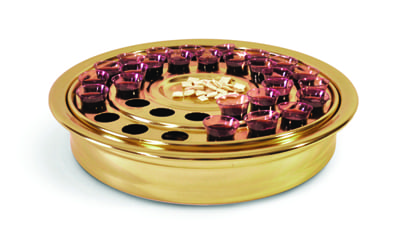 Dr. Jon R Roebuck, Exec. Director
Dr. Jon R Roebuck, Exec. Director
I spent 32 of the past 33 years pastoring different Baptist congregations here in the deep South. Some of the special moments, often celebrated in worship during those years, were those moments when the church celebrated the Lord’s Supper. My last church observed the Lord’s Supper once each quarter and also on Maundy Thursday of Holy Week. In most churches, there is a certain sense of decorum and ritual observed when passing the elements. Some of the special memories I treasure are those moments when I had the honor of passing the elements to our Deacons to serve the congregation. At our church, the Communion pieces were made of a light aluminum material which had the appearance of brushed copper. When empty, the trays which held the small, glass cups, were relatively light. But when filled, the trays took on a good deal of weight. Sometimes I would lift three or four trays from the “stack” to share with those serving the congregation. I have to admit that too many more would have been quite a load pick up. It was a significant weight.
In our tradition, the trays, made empty as members of the congregation each took their small cups, were brought back to the front of the church where I received them from the Deacons. I would carefully and quietly stack them back onto the Communion Table. I was always surprised at how much less they weighed. No longer filled with the elements of the Lord’s Supper, I could easily carry as many as needed. The difference, of course, was obvious. They had been filled with 40-50 small, glass cups of grape juice. They returned virtually empty. It was the weight of passion that had been removed.
Whenever we as believers share in the Lord’s Supper, the small, glass cups contain a symbol of our faith. The juice represents the spilt blood of Christ. To observe the supper is to celebrate the Lord’s redemptive sacrifice. To let the taste linger on the tongue is to be reminded again of that pivotal moment of sacrifice that changed the history of God’s interaction with humankind and brought hope to the world. It is the cup of life. It is the story of love told in symbol. It is a tangible connection to the sacrifice of Christ that reminds us that we have been set free from our burdens of sin. And in the context of worship, it is also a reminder of the fact that in Christ we are bound to each other in significant and important ways.
In the mind of Christ, I wonder how heavy is the weight of passion? For us, it’s different. We easily lift the small cup to our lips. For Christ, it’s the offering of His life. He bears the weight of the world… the collective burden of all our sins. But He does so willingly and lovingly. He does so in the hope that His actions will not be ignored, nor His sacrifice wasted. He dies for us that we might gain life. He longs for us to stand faultless in the presence of His Father. As Paul once wrote to the church in Corinth, “For God made Christ, who never sinned, to be the offering for our sin, so that we could be made right with God through Christ.” 2 Cor. 2:15 (NLT)
So, the next time you reach to take the small cup from the Communion tray that is passed in your direction, take a moment to remember that it’s heavier than you think.